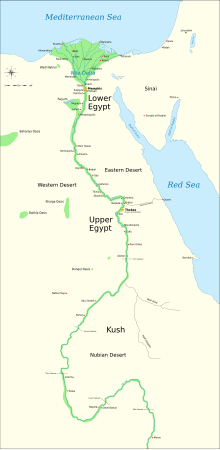User:Lellenkarsen/Buhen
Lead
[edit]Buhen, as a settlement was established during the Old Kingdom (2686-2181 BCE), but the fortress which Buhen is famous for was not established until the Middle Kingdom (2055-1650 BCE). During the Old Kingdom, Buhen was primarily used to smelt copper, until the Middle Kingdom, when the site was used by Egyptians to maintain the new southern border of Egypt.
History of Buhen
[edit]In the Middle Kingdom (2055-1650 BCE), the fortress at Buhen was established. The physical geography of Buhen worked in the benefit of the fortress. The large rock wall provided a strong preliminary base for the construction of the fortress. During the Middle Kingdom, the majority of people occupying Buhen were Egyptians who were directed South from Lower Egypt, and cycled through.[1]
Following the Middle Kingdom, came the Second-Intermediate Period. With the Second-Intermediate Period came the Funerary Stele of Sebek-dedu and Sebek-em-heb. The excavation of the stele produced a new understanding of the annexation of Nubia at the site of Buhen. The stele iterates that the Egyptians that had gained control over Buhen had been dependent on Nubian kings in achieving this.[2]
Fortress
[edit]One of the contributing factors for the creation of the fortress in Buhen was the goal of annexing Nubia. Both Senusret I and Senusret III dedicated much of their reign to campaigning into Nubia, in an attempt to extend the boundaries of Egypt. In doing so, the two kings built the fortress in Buhen, along with the other fortresses around the 2nd cataract. These fortresses established a new border for Upper Egypt.[3]

Added Map of Egypt (With location of Buhen relative to other cities) to article.

Added picture of funerary Stele.
Copper work at Buhen
[edit]After the copper had been smelted, it is likely that it was used for household and agricultural tools, from household knives to hoes for farming.[2]
References
[edit]- ^ Van De Mieroop, Marc (2021). A History of Ancient Egypt (2nd ed.). New York: Wiley Blackwell. p. 111. ISBN 9781119620877.
- ^ a b Shaw, Ian (2012). Ancient Egyptian Technology and Innovation. Bloomsbury Publishing Plc. ISBN 9781472519597.
- ^ Van De Mieroop, Marc (2021). A History of Ancient Egypt (2nd ed.). New York: Wiley Blackwell. pp. 110–111. ISBN 9781119620877.
- ^ Van De Mieroop, Marc (2021). A History of Ancient Egypt (2nd ed.). New York: Wiley Blackwell. p. 135. ISBN 9781119620877.
